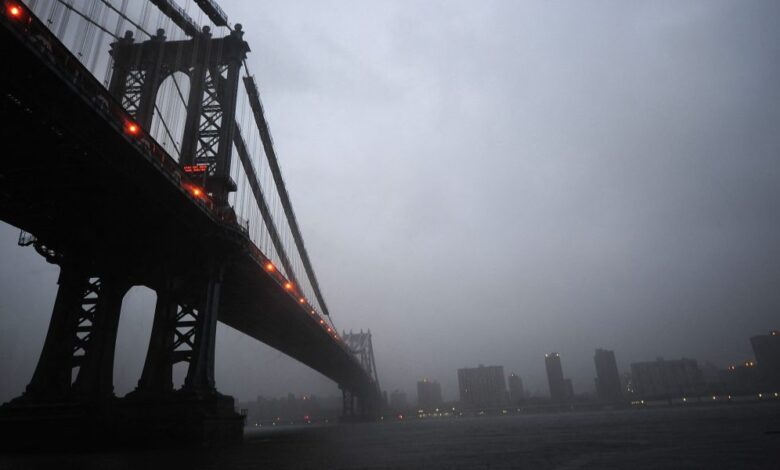Banking crisis could be fueled by climate change


America’s smallest banks face potentially devastating losses from climate-related weather disasters, according to first-of-its-kind study report from a climate change nonprofit. And they’re not even aware of the risks.
According to First Street, property damage from floods, wind, storms, hail, or wildfires threatens a total of $2.4 billion across nearly 200 national banks, representing an average of 1.5% of their total portfolio value. Most of this risk is concentrated among small regional or community banks. In fact, nearly one in three regional banks face significant climate risk. But large institutions are not immune, with one in four also exposed to such risks, the report said.
“The level of risk varies, but regardless of the size of the institution, all banks have some level of climate risk in their lending,” said Jeremy Porter, director of climate impact at First Street. Luck“The most vulnerable banks are small, regional and community banks with portfolios highly concentrated in areas prone to floods, wildfires or hurricanes. However, even some larger banks face risks large enough to warrant closer scrutiny.”
First Street conducted the analysis by looking at the severe weather risks at the bank’s physical locations and using them as a proxy for the commercial and residential properties the bank has lent on.
Nearly a third of domestic banks are exposed to climate-related risks that could reduce the value of their asset holdings by as much as 1%, a threshold the Securities and Exchange Commission defines as significant.
“If you have any item that, as a public company, has the potential to lose 1% of its value… you have to report it,” said First Street CEO Matthew Eby. “On average, every one of these small banks and community banks has a lot of risk, they [would] All must report.”
Why banks don’t know
The SEC’s 1% rule is currently on hold while it faces legal challenges—but regardless, the rule and other financial reporting requirements exempt small banks. Experts say many of these institutions may not know how risky their portfolios are. And the skyrocketing costs of weather related disasterexpected to increase significantly when climate change is getting worseshows why understanding such risks is important. Since the 1980s, floods, wildfires, hurricanes, and other weather disasters have caused increasing financial losses, largely in areas that were previously immune to weather disasters.
Hurricane Debby hit Florida and the Carolinas last month. move to the East Coastcaused an estimated $1.4 billion in property damage. in the United States. and more $2 billion in Canadaby estimates. (It was the most expensive event in Quebec’s history, Reinsurance News noted.) But an analysis by First Street establish that nearly 8 in 10 losses were outside FEMA’s historic floodplain, meaning affected properties were unlikely to have flood insurance and their owners were less likely to survive catastrophic financial losses.
Repeated across hundreds or thousands of properties, such financial losses can spell disaster for small banks whose outstanding loans are concentrated in a particular area. One bank flagged by First Street as high risk has most of its branches throughout coastal New England, an area that has seen consecutive floods devastated give last two years and where climate change is expected to occur aggravate severe weather.
“If after insurance you lose 14 or 15% of your residential real estate portfolio or your commercial real estate portfolio, you don’t have enough reserves to withstand that, so you’re talking about the possibility of a bank failure,” Eby said.
“Financial institutions are really a big concern, because if they go bankrupt in financial crises, it affects everyone, as opposed to just one company going bankrupt,” he added.
The unknown
While climate risk is a growing concern for banks of all sizes, the smallest institutions are the least able to establish and price that risk, said Clifford Rossi, former chief executive of Citigroup Inc. risk management professional currently directing the Smith Enterprise Risk Consortium at the University of Maryland.
“There are a lot of other factors that are affecting small banks – they are facing competitive pressure from larger players that are affecting economies of scale, they are focusing on how they manage their assets, interest rates are falling… those are the top factors,” he said.
Rossi questions First Street’s methodology and warns against making estimates of bank losses based on branch location, as they can provide very different numbers.
“There is certainly some level of risk in those portfolios, but we don’t know how much,” he said.
Every bank should conduct portfolio analysis at the loan level by feeding address, longitude, latitude and commercial real estate data into climate models to assess physical risk, he added.
When it comes to estimates, he cautions, “We need to be careful about saying the sky is falling when we don’t have the best analysis yet.”
But that kind of analysis is time-consuming and difficult, even for the largest institutions. The Federal Reserve this spring released the results of a Test to determine the awareness levels of the six largest US banks—Bank of AmericaCitigroup, Goldman Sachs, JPMorgan Chase, Morgan Stanleyand Wells Fargo—are their climate risks.
Answer: Not much.
Banks say they don’t have reliable information about the types of buildings they hold, their insurance coverage, their weather exposure or climate modeling data.
This new analysis “highlights the need for all banks, financial institutions and asset owners to proactively incorporate climate risk into their broader risk management framework,” said First Street’s Porter.
“Climate risk is present in these portfolios—and it is measurable. The Federal Reserve, SEC, and other regulators have acknowledged this risk through stress tests, and it is only a matter of time before mandatory reporting becomes standard practice.”




